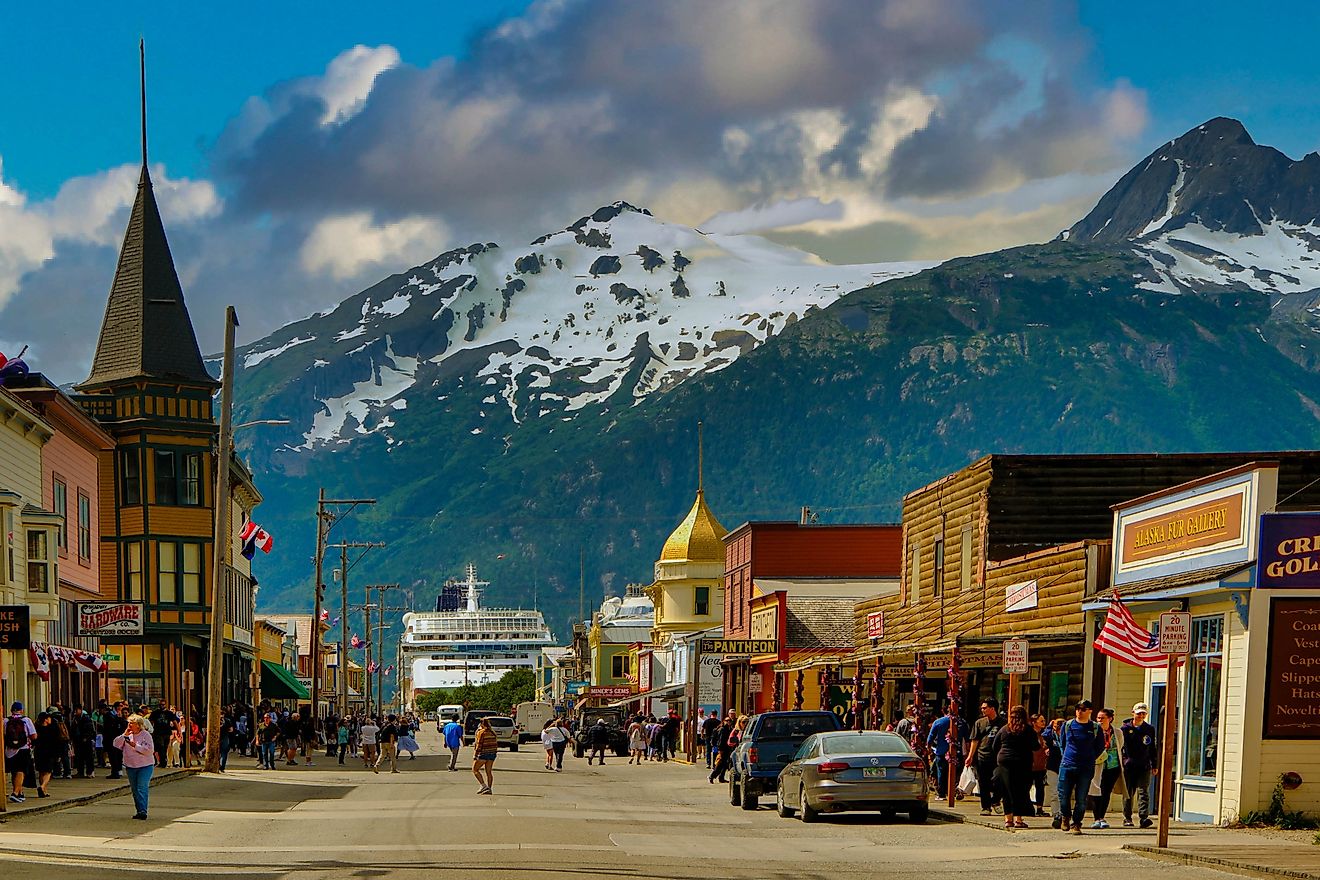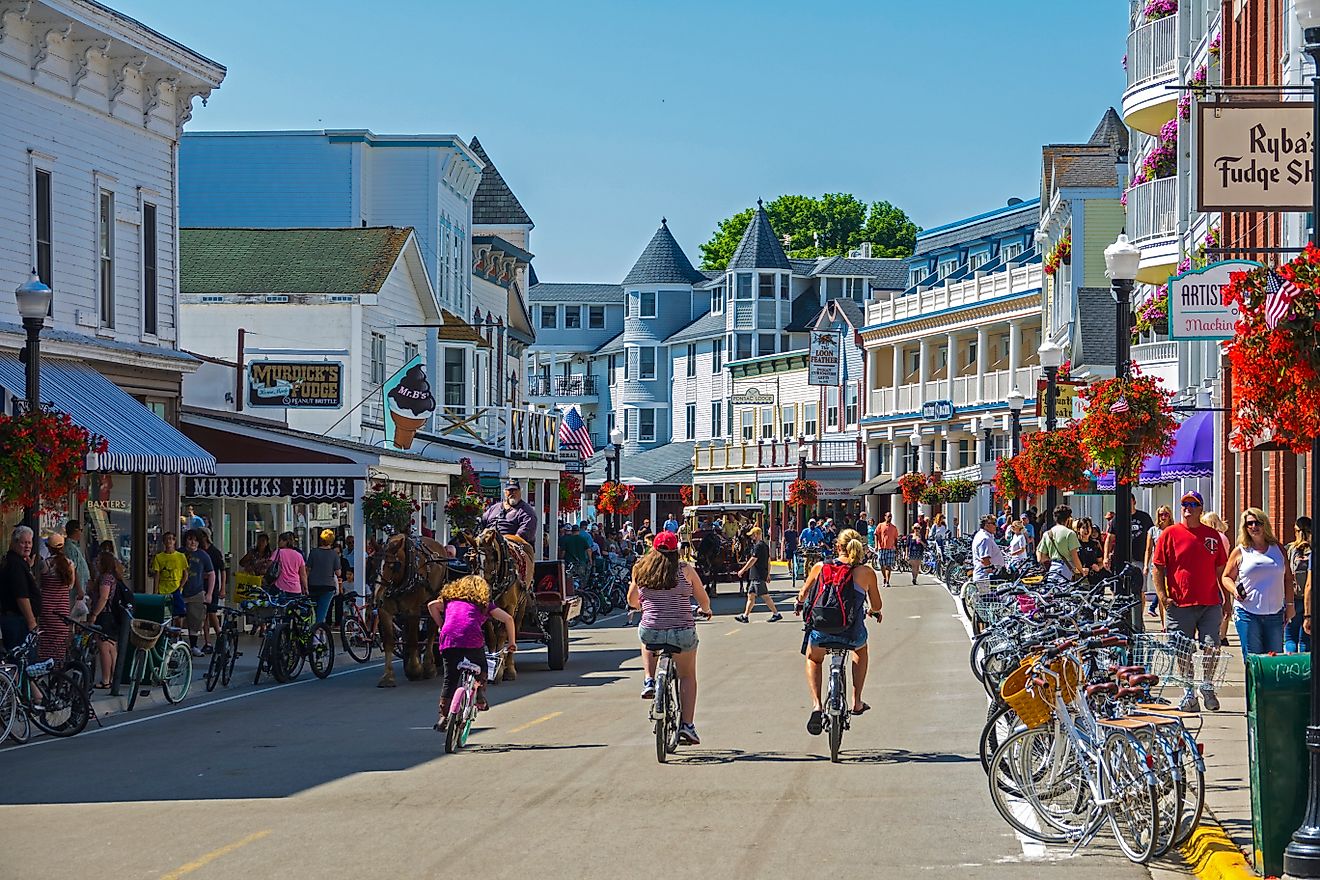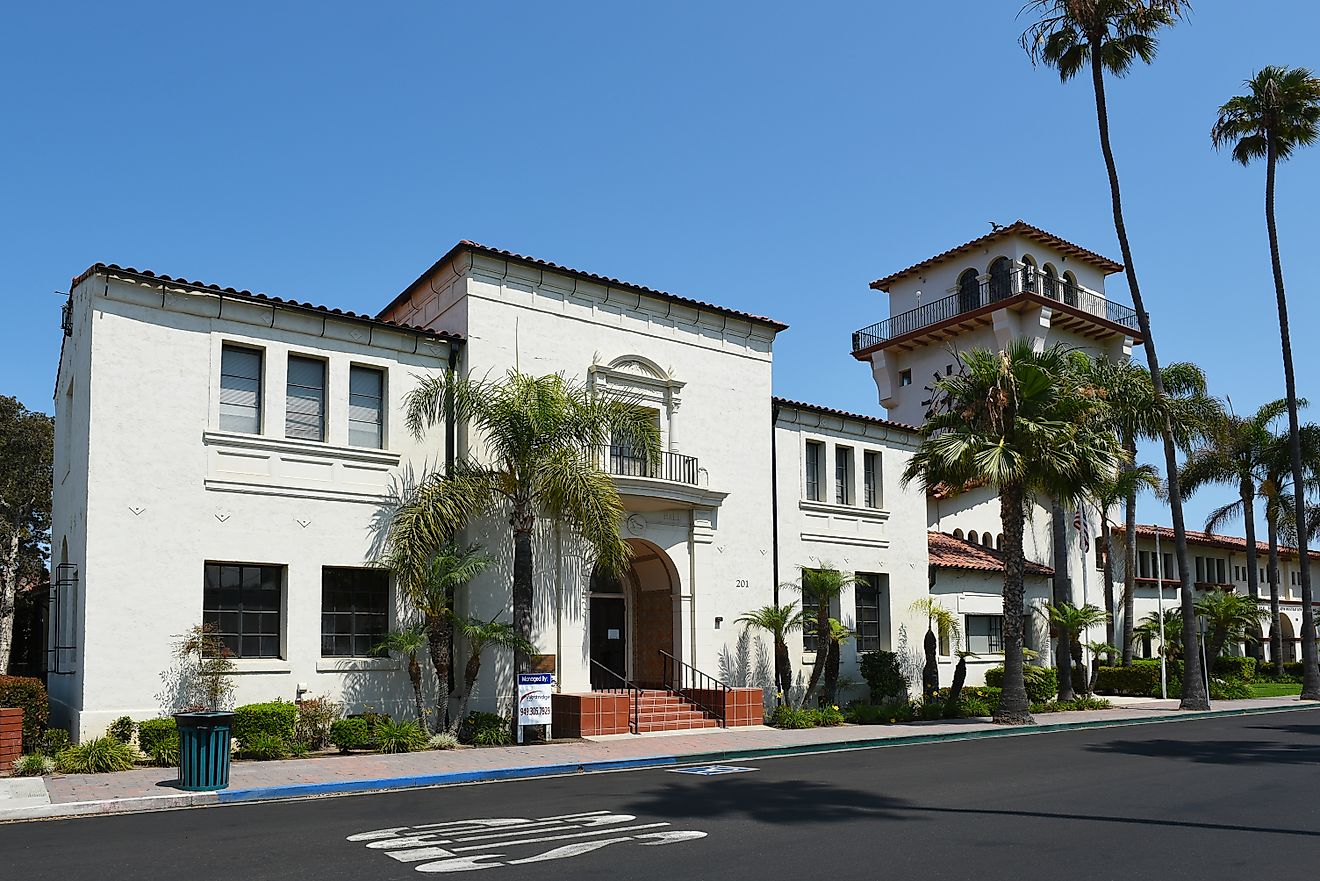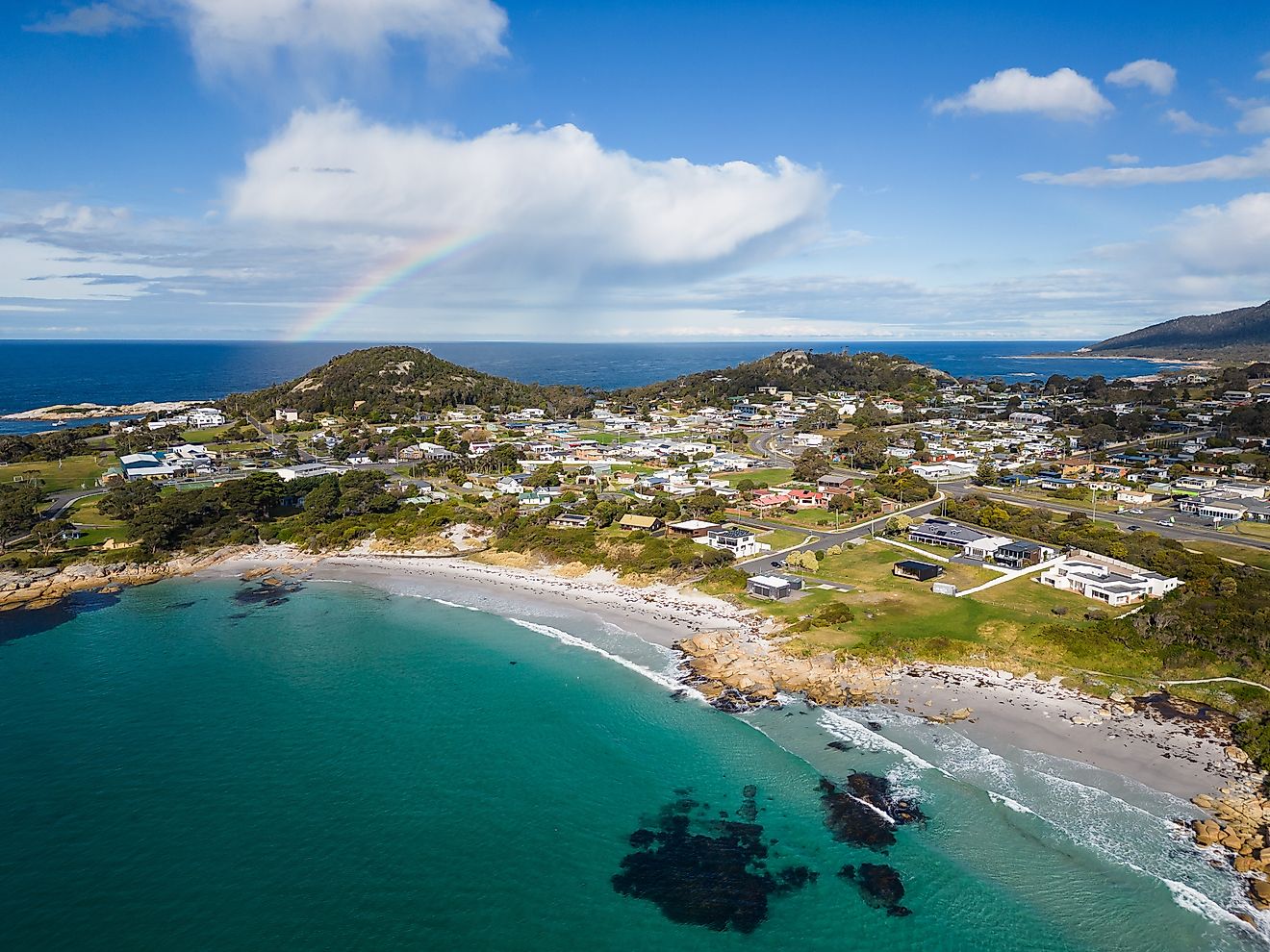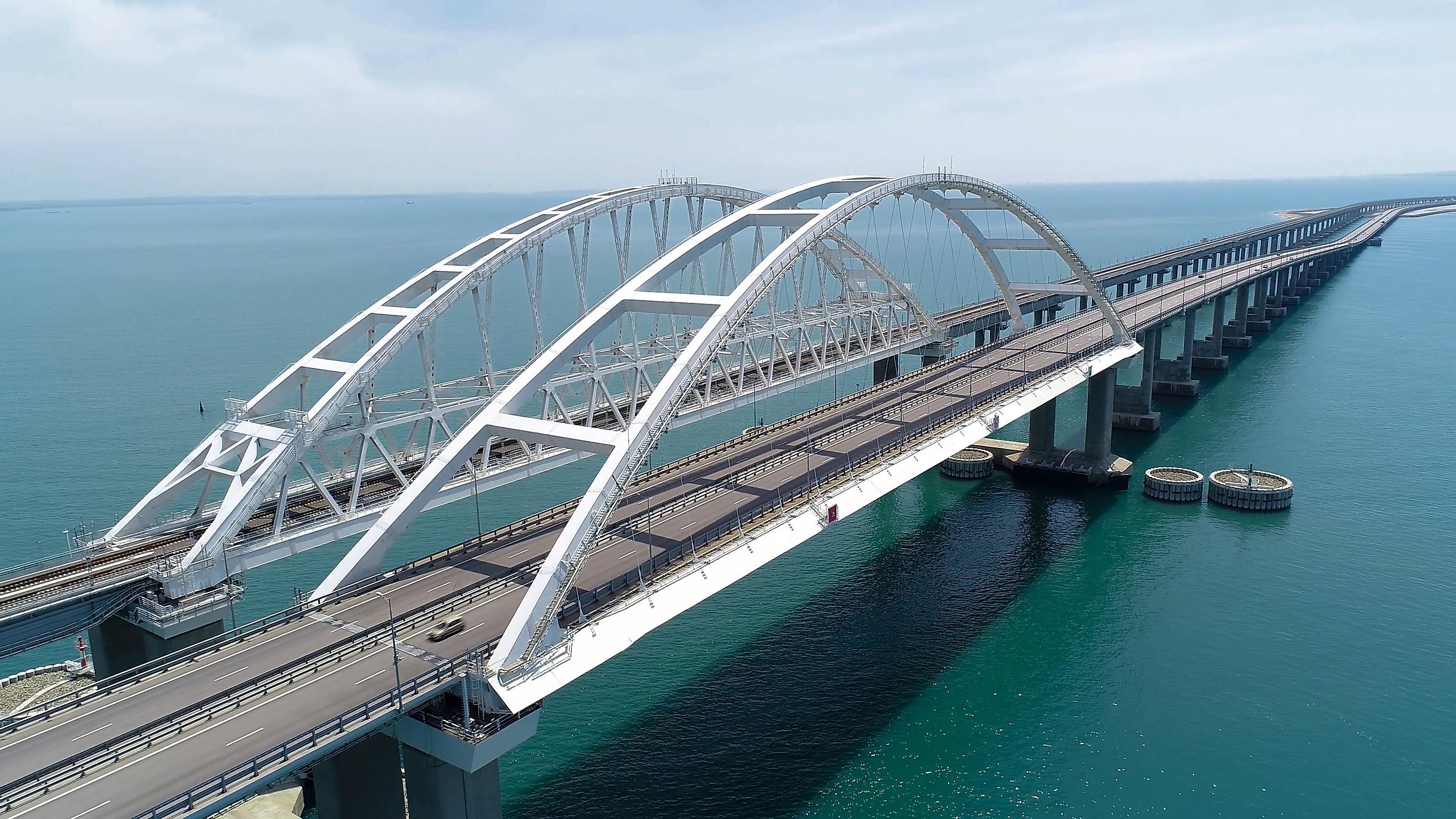
The Longest Bridges in Europe
Europe is the place you go when you seek historic architecture, but the talent for art and erecting pieces that are meant to stand the test of time is in its blood. Its longest bridges are real engineering feats, marvelous to the eyes, and must-experiences when in the country to learn more about their construction and function. These feats of engineering are highly celebrated landmarks with tons of tourist allure.
Discover the symbolic meanings, like the freedom of movement or the speed at which the trains whizz along the sleek tracks, akin to futurism. The longest bridge in Europe today is located in Russia, with quite a few more in Portugal and Germany, as well as in the Nordic countries of Denmark and Sweden. You will also notice that Italy is the country of many bridges for a reason, featuring some of the longest ones in Europe in the attached list of 25.
1. Crimean Bridge (Kerch Strait), Russia: 18.1 km
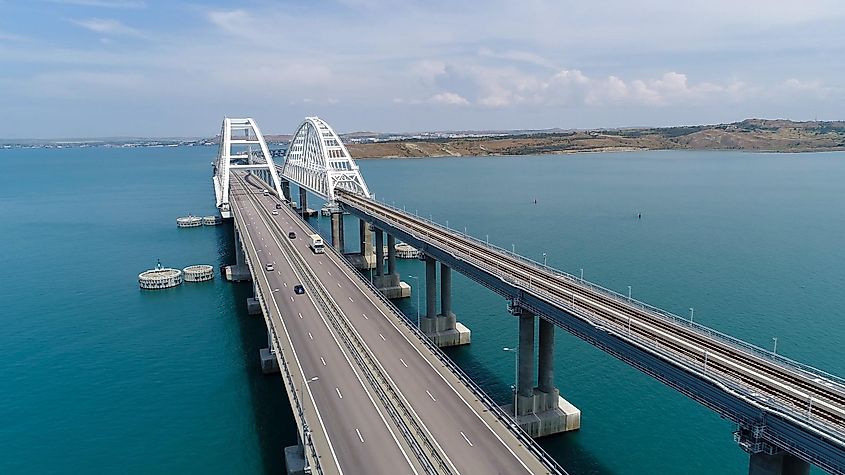
The Crimean Bridge, opened with fanfare by Russia's President Vladimir Putin in 2018, is the longest bridge in Europe. With a clearance below 35 meters and the longest span of 227 meters (745 ft), the railroad bridge totals 18.1 km in length (11.25 mi), and the road bridge is 16.9 km (10.5 mi) long. The construction of this double parallel railroad-road truss arch bridge started in February 2016 and was designed for road and rail paths over the Kerch Strait, where the water depth is up to 9 m (30 ft).
Some regard Putin's gesture of a grand opening as a symbol of taking over Ukraine and binding it with Russia forever, as the bridge is a vital connection to supply the country's military in Crimea. Having annexed the Crimean Peninsula from Ukraine in 2014—an act deemed illegal by many Western countries—the bridge became a target of increased air and sea drone attacks by Ukraine following the start of the war between the two countries. With suspensions and reopenings, the bridge closed again on Sunday, September 3rd, but according to the administration, this is a temporary closure.
2. Vasco da Gama Bridge, Portugal: 17.2 km
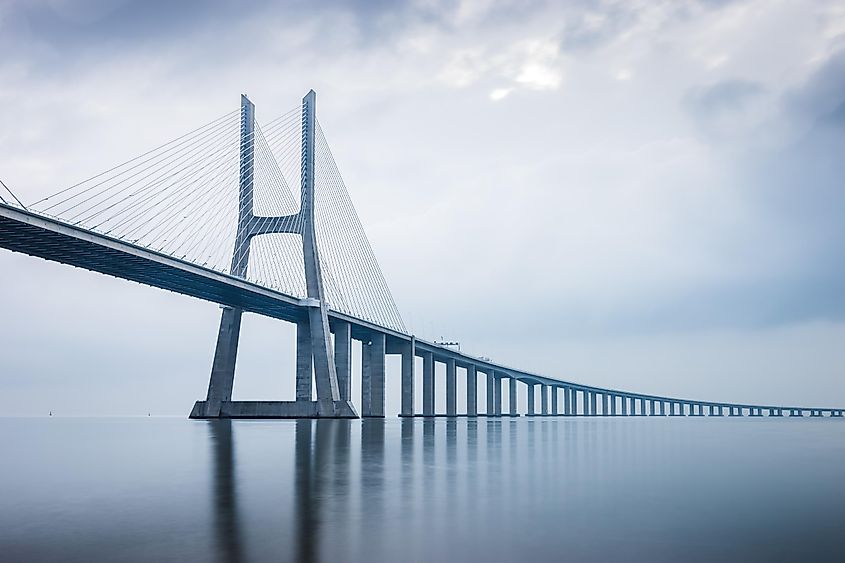
The highway-purposed Vasco da Gama Bridge in the northern region of Lisbon, Portugal, is the second-longest bridge in Europe, stretching for over 17.2 km (10.7 mi). It was initially planned to alleviate the congestion on the other bridges in the city, and this bridge also prevents traffic between the north and south of the country by allowing access to multiple road sections. At that time, the bridge cost a whopping USD 1.1 billion and took 3,300 workers 36 months to build. It was completed in 1998 under the official name Ponte Vasco da Gama and the ownership of the Portuguese Republic.
Thanks to the immense planning during construction, the Vasco da Gama Bridge holds six road lanes and has a life expectancy of 120 years. Moreover, it can withstand wind speeds of up to 250 km/h and allows vehicles to drive at up to 120 km/h. Thus, the Vasco da Gama Bridge is a feat of engineering and one of the country’s most famous landmarks.
3. Emsland Test Facility, Germany: 12 km
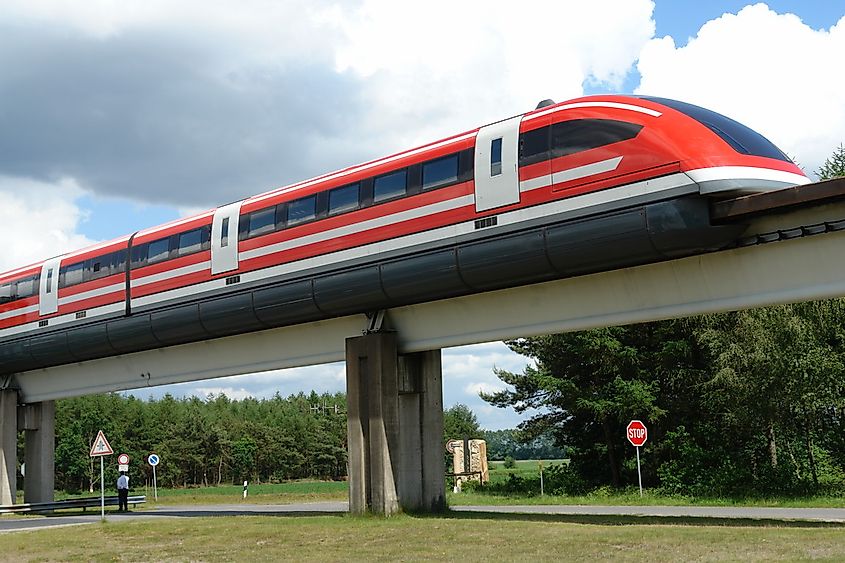
The Emsland Test Facility is the third longest bridge in Europe, spanning 12 km (7.5 mi); however, it is a bit different from the other bridges on this list. This is because instead of an active road or rail bridge, it is a defunct testing site for Transrapid maglev trains, a single-track line between Dörpen and Lathen in Emsland, Germany. The elevated track, so as not to interfere with the surrounding farmland and grazing, also features turning loops at each end. Built by the German company Transrapid International, the construction began in 1980 and ended in 1984, after which operations began. By 1987, the 31.5 km-long test line was a regular tourist attraction for the curious to "test" these new trains, which reached speeds up to 420 km/h.
While the train started as a success, a freak accident led to its subsequent closure. The accident took place on September 22, 2006, when the workers didn't get a response after checking for garbage along the line before the first morning train. They also needed to be made aware that an additional test run was planned with tourists, including employees of the Transrapid company. The dispatcher also failed to remember the workers and a 60-ton diesel service machine on the track when Transrapid 08 started as usual and hit the obstacle at 162 km/h. Thus, due to human error, 23 people were killed, and 11 were seriously injured. The facility closed at the end of 2011 due to the expiration of the operation license and was approved for demolition in early 2012.
4. Leziria Bridge, Portugal: 11.67 km
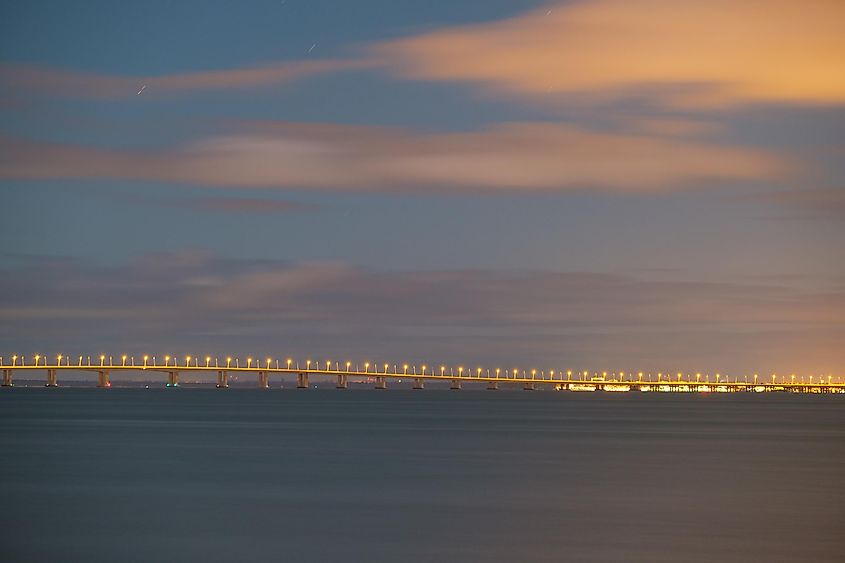
Leziria Bridge, northeast of Lisbon, crosses two rivers: the bigger Tagus River and the smaller Sorraia River, in a connection between the cities of Carregado and Benavente. At 11.67 km (7.25 mi) long, this box girder bridge and viaduct bridge is the fourth longest bridge in Europe, with the longest span of 972 m (3,189 ft). The construction began in July 2005 and took 23 months to complete using the balanced cantilever method by 2007. For construction, 400,000 cubic meters of concrete, 45,000 tons of steel, and 52,300 cubic meters of foundation piles were used.
The bridge cost 220 million euros (USD 260 million) by the time it opened on July 8, 2007, under the official name of Ponte da Leziria. Maintained by Brisa, this two-way, 6-lane high-speed bridge hosts motorways with a speed limit of 120 km/h. Its renowned, innovative toll collection system is technologically advanced to reduce manual charging and make it more efficient for the vehicles on site, with a toll fee of 1.25 euros northbound and southbound.
5. Öresund Bridge, Denmark/Sweden: 7.845 km
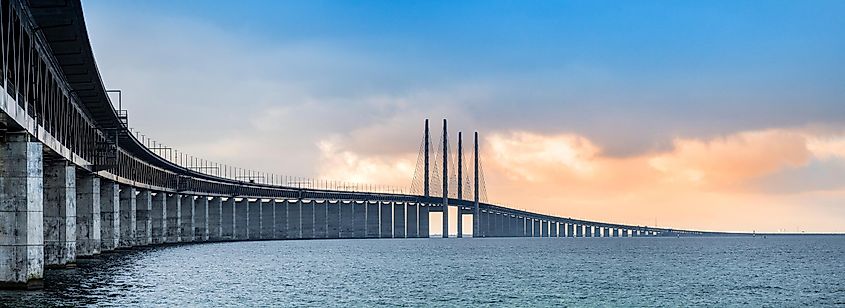
Comprising almost half of the nearly 16 km (9.9 mi) of direct link over the Öresund (the Sound) between Denmark and Sweden, this toll bridge is the longest in Denmark and the fifth longest bridge in Europe. Designed by the leading architect Georg K.S. Rotne, the Öresund Bridge was completed in 1999 and opened in 2000 for highway and rail. Spanning 7.845 km (4.87 mi) in length, the bridge, the connected Drogden Tunnel, and the artificial island of Peberholmen connect the two countries.
With a long and convoluted history as a witness to many events in Nordic cooperation in the economy and engineering, the bridge is a symbolic link in cross-border relationships. From freedom of movement in the past to a physical connection between continental Europe and the removed Nordic countries, hundreds of thousands of cars and trains have used the bridge, a globally renowned icon, to this day. The toll booths are on the Swedish part of the bridge, and there are more recently policed borders with identification checks.
6. Great Belt Bridge (Eastern), Denmark: 6.79 km
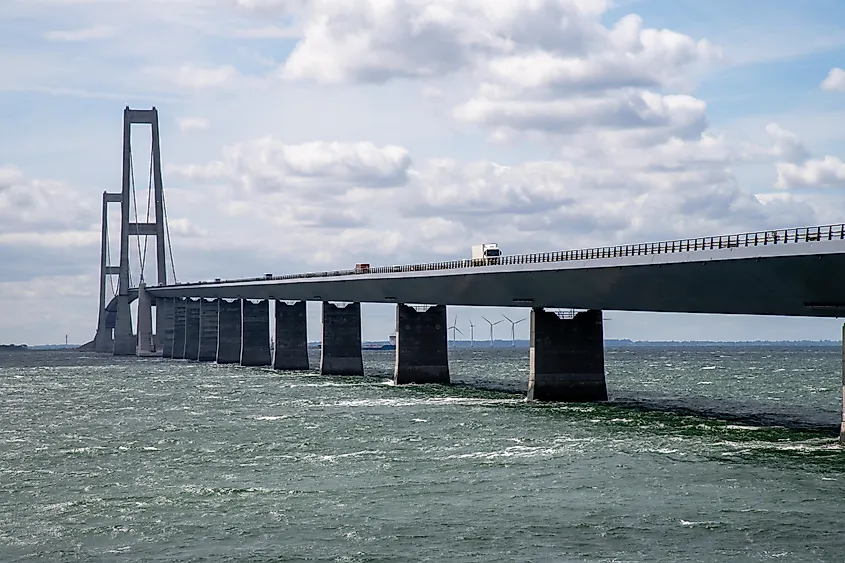
The Great Belt Bridge is the sixth-longest in Europe and the second-longest bridge in Denmark. Built in 1998, its two 254-meter (833 ft) towers are the highest points in the country, bearing cables with a free span of 1,624 meters (5,328 ft)—the second-longest in the world. The mammoth work put into its construction in Denmark makes getting around the country's regions much easier. Ode to this, the 6.79 km (4.21 mi) long Eastern Bridge hosts over 27,000 cars on average and up to 40,000 vehicles a day in the peak summer season.
The Great Belt Bridge's characteristic cable profile with a passage height of 65 meters (213 ft) and its massive pylons make it a popular symbol of Danish expertise and sound craftsmanship. This bridge is part of the 18-kilometer-long Great Belt Fixed Link between the Zealand and Funen regions, built between 1988 and 1998. The total link comprises the suspension Eastern Bridge, the low-level Western Bridge, and the under-the-sea Eastern Tunnel for the railway, which, at 8,024 meters long, is the second-longest bored tunnel in Europe. There is a toll fee to get across, including to the little island of Sprogø with its lighthouse in the link where the bridges and the tunnel meet.
7. Great Belt Bridge (Western), Denmark: 6.61 km
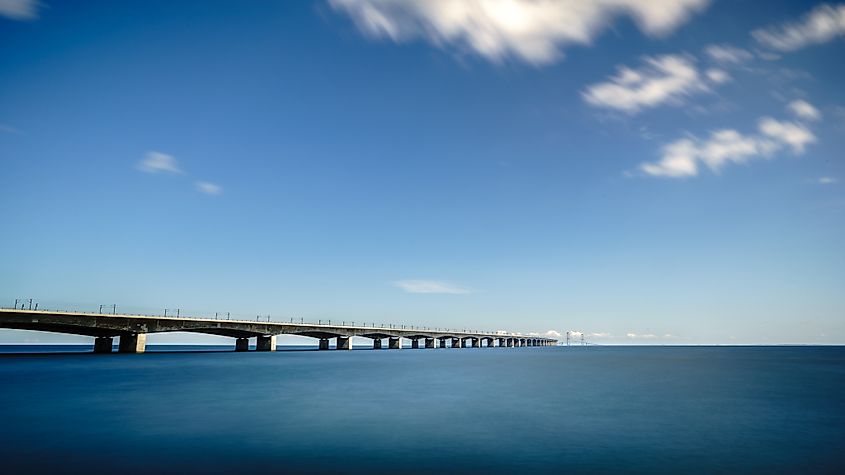
The Great Belt Bridge (Western) is Europe's seventh-longest bridge and Denmark's third-longest at 6.611 km (4.1 mi). This 25-meter-wide bridge features 62 piers and 63 spans, each for one road and railway girder, 51 measuring 110 meters, and 12 spans measuring 82 meters. It was built between 1988 and 1994 and opened with the link for rail and road traffic in 1998.
Both the superstructure and substructure are made of concrete from the factory Lindholm on Funen, and the elements were transported to the bridge by the floating crane, Svanen. The aforementioned little island of Sprogø offers an unusual way to experience the bridge on a guided foot journey, narrating its history and seeing the bridge close at hand.
8. Saale-Elster Viaduct, Germany: 6.465 km
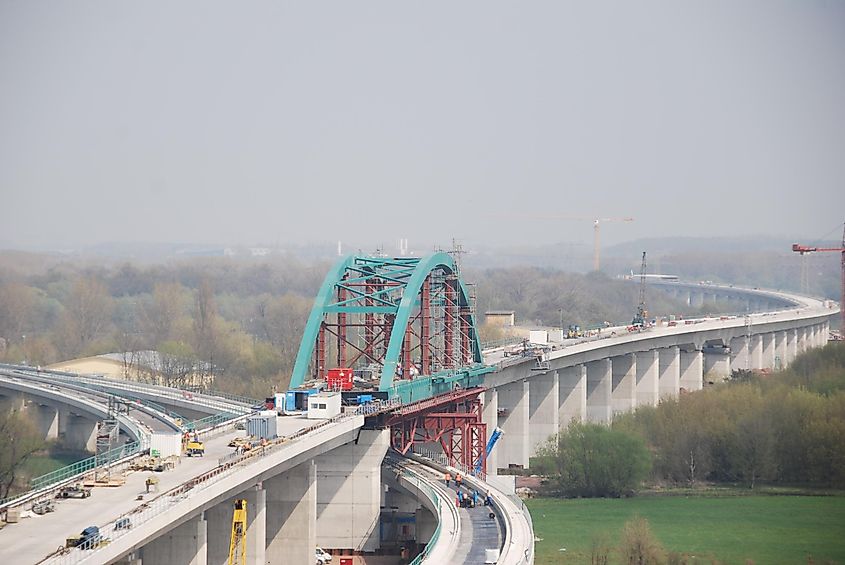
The railway bridge of the Saale-Elster Viaduct, part of the connection between the cities of Munich and Berlin, runs along the Erfurt-Leipzig/Halle line for high-speed trains in Central Germany, just south of Halle, Saxony-Anhalt. Built between 2006 and 2013, it opened in 2015 and is the eighth-longest bridge in Europe at 6.465 km (4 mi) in length. Built for Deutsche Bahn Intercity-Express (ICE), this prestressed concrete railway bridge comprises regular spans of 44 m and an arch bridge with a span of 110 m at the confluence of the Saale and White Elster rivers.
Featuring a 2,112-meter (6,929-foot) branch that connects to the parallel Halle-Bebra railway line over the valley, the total length of over 8.6 km would make it the country's longest overall bridge structure. The bridge hosts the new DB line across the floodplain landscapes of the Saale and Weißen Elster. With a 300 km/h design speed, this first German railroad network-tied arch bridge is recognized as part of the future high-speed railway. It features an exposed aesthetic profile—a real engineering marvel highlighting the entire structure. The fatigue-resistant details for all connectors, among other features, are based on the aerodynamic design for high-speed railway traffic. Moreover, the bridge spans several nature reserves, bird sanctuaries, and water protection zone III of the Halle-Beesen waterworks, south of Halle.
9. Öland Bridge, Sweden: 6.07 km
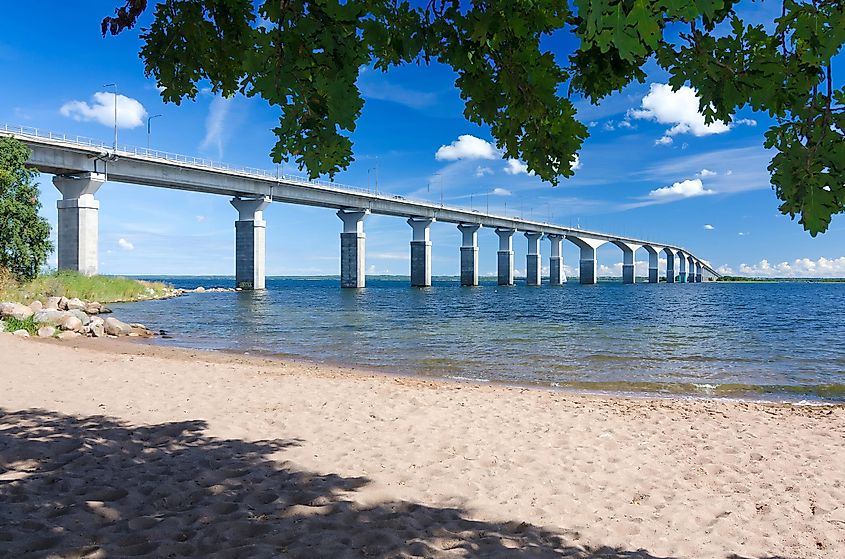
Öland Bridge is a long-planned permanent link between Öland and Sweden’s mainland, with a history of parliamentary motions and inquiries and the first concrete proposal in 1932. On November 18, 1966, the Swedish government officially accepted Öland Bridge as part of the construction of long bridges in the country. The then Minister for Communications, Svante Lundkvist, turned the first sod the day before the New Year's celebration in 1967, and almost five years later, Öland Bridge opened on September 30, 1972. Spanning 6.072 km (3.77 mi), it was the longest bridge in Europe until 1998, when the Vasco da Gama Bridge was constructed. Moreover, it is the longest bridge in Sweden since the longer Öresund Bridge mentioned above only partially lies in the country.
The bridge features 155 spans made from reinforced concrete and six spans that measure 130 meters each along the highest section. It is also large in other dimensions, with a width of 13 meters, a vertical clearance of 36 meters, and a peak height of 41.69 meters. Ode to this, it is a highly functional and celebrated landmark hosting the secondary road 137, which connects to the E22 on the mainland and the secondary road 136 on Öland. Along with connectivity, the 6-kilometer-long bridge is a popular tourist destination providing an aesthetic experience with nearby recreation, entertainment, and even nature opportunities. Thus, this toll-free bridge is an iconic art piece and famous traffic solution with loads of history, having just celebrated its 50th anniversary in 2022.
10. President Bridge, Russia: 5.825 km
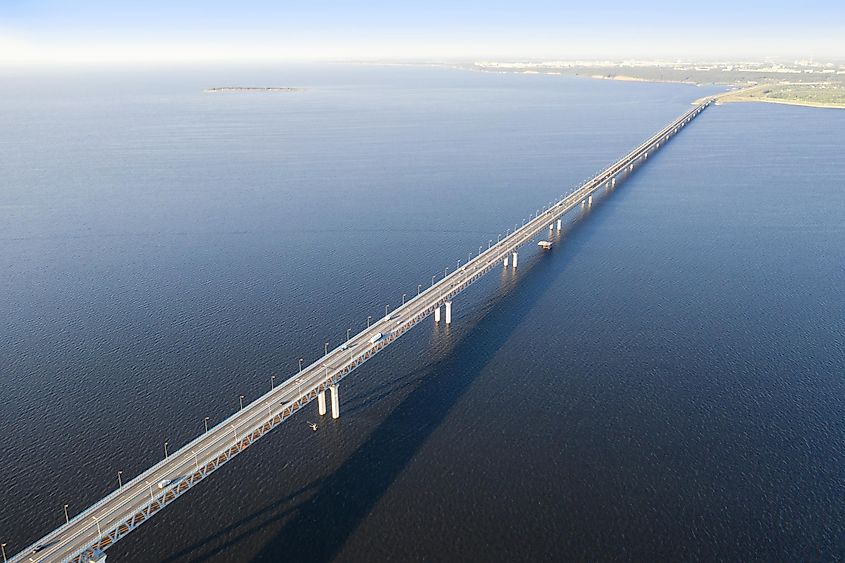
Located in Ulyanovsk Province in central Russia, the President Bridge is one of the country's most popular and longest bridges. Completing the list as the tenth longest in Europe, it spans across the two banks of the Volga River, connecting the province's capital city with the eastern part of the province over 5.825 km (3.62 mi). With construction beginning in late 1980, due to the problems in the country, it has taken over two decades to complete the bridge, bringing it into the post-Soviet Russia era when it finally opened in 2009. Upon completion, the truss bridge significantly boosted local infrastructure and transportation. Featuring 25 spans, President Bridge handles some 40 thousand vehicles a day, which is its average traffic volume. To this end, it is one of the most used bridges in the world and a feat of engineering.
The girth these bridges withhold while upholding a prolific scene for the country's pride and the joy of tourists is admirable. Seemingly defying all natural forces with captivating profiles, courtesy of creative designers, witty engineers, and hardworking constructors, it is a vision and functionality brought to life. Doing seemingly unnatural tasks akin to time travel, these bridges cut the journey for locals between regions to mere minutes. Do your due diligence when in the country to speed along one of these marvels, and you will get a spark in your eye along these welcomed miles after your routing traffic horror or mundane driving days back home.
| Rank | Bridge Name | Location | Length (Kilometers) | Length (Miles) |
|---|---|---|---|---|
|
1 |
Crimean Bridge |
Russia |
18.1 |
11.25 |
|
2 |
Vasco da Gama Bridge |
Portugal |
17.2 |
10.69 |
|
3 |
Emsland Test Facility |
Germany |
12 |
7.46 |
|
4 |
Leziria Bridge |
Portugal |
11.67 |
6.83 |
|
5 |
Öresund Bridge |
Denmark/Sweden |
7.85 |
4.87 |
|
6 |
Great Belt Bridge (Eastern) |
Denmark |
6.79 |
4.21 |
|
7 |
Great Belt Bridge (Western) |
Denmark |
6.61 |
4.1 |
|
8 |
Saale-Elster Viaduct |
Germany |
6.47 |
4 |
|
9 |
Öland Bridge |
Sweden |
6.07 |
3.77 |
|
10 |
President Bridge |
Russia |
5.83 |
3.62 |
|
11 |
Amur Bay Bridge |
Russia |
4.36 |
2.7 |
|
12 |
Ponte Salgueiro Maia |
Portugal |
4.3 |
2.67 |
|
13 |
Hochstrabe Elbmarsch |
Germany |
4.26 |
2.65 |
|
14 |
Anghel Saligny Bridge |
Romania |
4.09 |
2.54 |
|
15 |
Kohlbrandbucke |
Germany |
3.94 |
2.44 |
|
16 |
Yuribey Bridge |
Russia |
3.89 |
2.42 |
|
17 |
Khabarovsk Bridge |
Russia |
3.89 |
2.42 |
|
18 |
Ponte della Libertà |
Italy |
3.85 |
2.39 |
|
19 |
Santhià Viaduct |
Italy |
3.78 |
2.34 |
|
20 |
Fadalto Viaduct (Southbound) |
Italy |
3.57 |
2.21 |
|
21 |
Fadalto Viaduct (Northbound) |
Italy |
3.49 |
2.16 |
|
22 |
Viadotto Imera II |
Italy |
3.37 |
2.09 |
|
23 |
Saint-Nazaire Bridge |
France |
3.36 |
2.08 |
|
24 |
Nurly Zhol Bridge R |
Kazakhstan |
3.2 |
1.99 |
|
25 |
Storstrøm Bridge |
Denmark |
3.19 |
1.98 |
